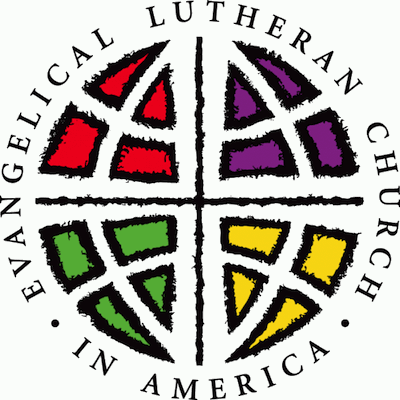By Andrew E. Harrod (@AEHarrod)
Optimism literally projected on screen at theEvangelical Lutheran Church in America’s (ELCA)2013 Churchwide Assembly in Pittsburgh running from August 12-17, 2013, cannot ultimately hide the membership decline that has accompanied this denomination since its origins in 1987. Although much heralded 25 years ago as a unification of American Lutherans, the ELCA’s anniversary slogan of “Always Being Made New: 25 Years Together in Christ” on display at Pittsburgh’s David L. Lawrence Convention Center rings bitterly ironic in light of ECLA’s dwindling, aging congregants and sinking contributions. Liberal theology and politics in America’s so-called Mainline Protestant denominations apparently just gets older and older.
ELCA’s slogan, taken from 2 Corinthians 5:17, is present throughout the convention hall, including a slide show highlighting ELCA milestones on a large screen during assembly breaks. As the ELCA website explains, the denomination resulted from the January 1, 1988, merger of the American Lutheran Church, the Association of Evangelical Lutheran Churches, and the Lutheran Church in America following a 1987 conference in Columbus, Ohio. ELCA’s founding “was a heady time, producing the successful merger of two-thirds of America’s Lutherans gathered under one denomination,” wrote Pastor Russell E. Saltzman in 2011 at First Things after having broken away from ELCA with other conservative Lutherans to form theNorth American Lutheran Church (NALC). “Lutherans had finally achieved part of the dream, all Lutherans in America in one Evangelical Lutheran Church.”
Yet since the launch of ELCA its course has been permanently downward. The ELCA’s own statisticsshow that after 5,288,048 Lutherans came together in 1987 to form the denomination, only 4,059,785 remained in ELCA in 2011, the latest year of available data. In all, this is a “staggering loss of over 1.2 million members, or 23% of their membership,” Rev. Kevin Vogts of the conservative Lutheran lay organization Steadfast Lutherans notes. The number of ELCA congregations has also dropped from 11,138 at the 1987 founding to 9,638 in 2911, a loss of about 13%. “As they ‘celebrate’ this year the 25th anniversary of the ELCA,” Vogts observes, “the fact is that during that time they have lost more members and congregations than make up many entire denominations!”
Almost every year of ELCA’s existence has witnessed membership loss, particularly the 270,349 and 212,903 leaving in the succeeding years 2010-2011. The loss of each of these two years averaged more than five percent of ELCA’s total membership. This followed the2009 Churchwide Assembly decisions to allow individual congregations “to recognize, support and hold publicly accountable life-long, monogamous, same-gender relationships” and for individuals in such relationships to serve as ELCA leaders. Only the years 1990 and 1991 ever showed any ELCA membership growth of 1,941 and 4,438 congregants, respectively.
Such membership losses have financial consequences. Vogts calculates that national ELCA donations in 2008 were $88 million, but dropped to $40 million in 2011. Luther Seminary in St. Paul, Minnesota, the ELCA’s largest, announced in 2012 a $6 million operating deficit on a $27 million budget. Reportedly one couple had given $1 million annually to the seminary but stopped after ELCA’s pro-gay decisions. Luther Seminary had to cancel programs and lay off a third of its staff as a result.
By comparison, the conservative Lutheran Church-Missouri Synod (LCMS) counted 2,278,586 members in 2010. The equally conservative Wisconsin Evangelical Lutheran Synod (WELS) claims over 300,000 communicants. The NALC now claims 130,000 members, mostly disaffected ELCA members like Saltzman. Another destination for disappointed ELCA members is the Lutheran Congregations in Missions for Christ (LCMC), now listing 808 congregations, more than double NALC’s 345 congregations.
ELCA’s remaining members are getting older as well. An October 2008 ELCA study found that the median age of denomination churchgoers between the ages of 15 and 99 was 58, while the general American population had a median of 39. Assembly visitors in Pittsburgh might not know this, given that 110 or roughly one-in-nine voting members were born after 1988. Yet the Constitutions, Bylaws, and Continuing Resolutions of the Evangelical Lutheran Church in America 2011 establish in 6.02.A09 a “goal of this church” of “at least 10 percent of the voting members of the Churchwide Assembly, Church Council, and churchwide boards and committees” being “youth” under 18 and “young adults” between 18 and 30.
ELCA’s stance on homosexuality and other matters has had international effects. Vogts notes that “many of the largest and fastest-growing Lutheran church bodies in the world” have cut “historic ties” to ELCA” in favor of LCMS. These include Ethiopia’s six million Lutherans, “nearly as many as all American Lutheran church bodies combined,” the Evangelical Lutheran Church of Liberia, Siberian Evangelical Lutheran Church, and the Lutheran Church of Togo. The “center of world Lutheranism is shifting from Europe and America to Africa, Asia, and South America, and the LCMS is becoming the theological leader of these growing Lutheran church bodies.” ELCA, meanwhile, “is becoming increasingly isolated in world Lutheranism.”
ELCA is thus repeating the ecumenical pattern of churches that abandon Biblical standards already manifested by the Episcopal Church’s 23% loss in average Sunday attendance across the decade 2000-2010. Apparently, devote Christians do indeed heedRomans 12:2’s admonition to “be not conformed to this world.” After all, it is obedience to eternal standards and not the latest societal mood that is truly novel. Wherever churches no longer preserve the “salt” and “light” of the Bible and natural law, the faithful vote with their feet and finances.
'via Blog this'

